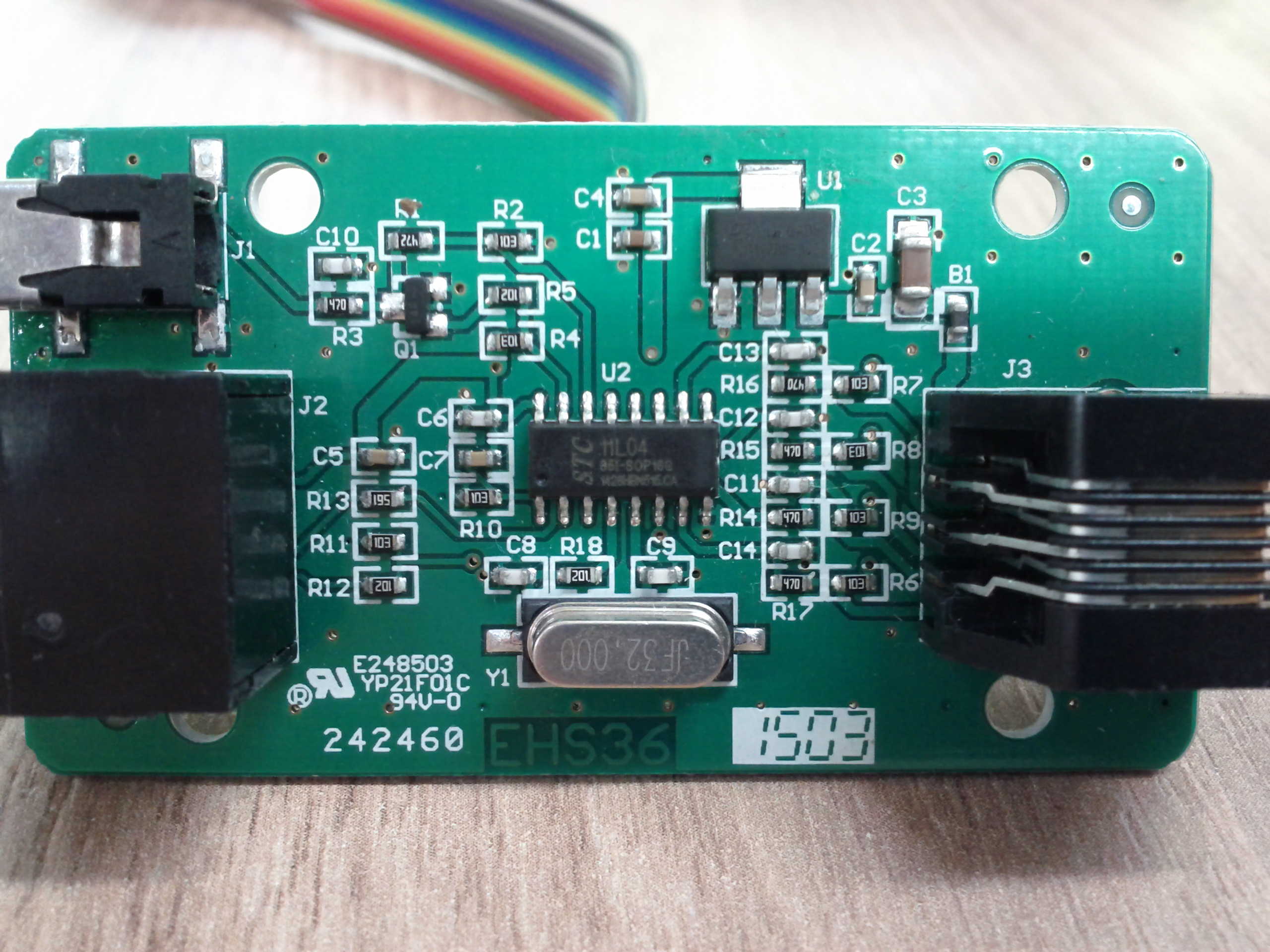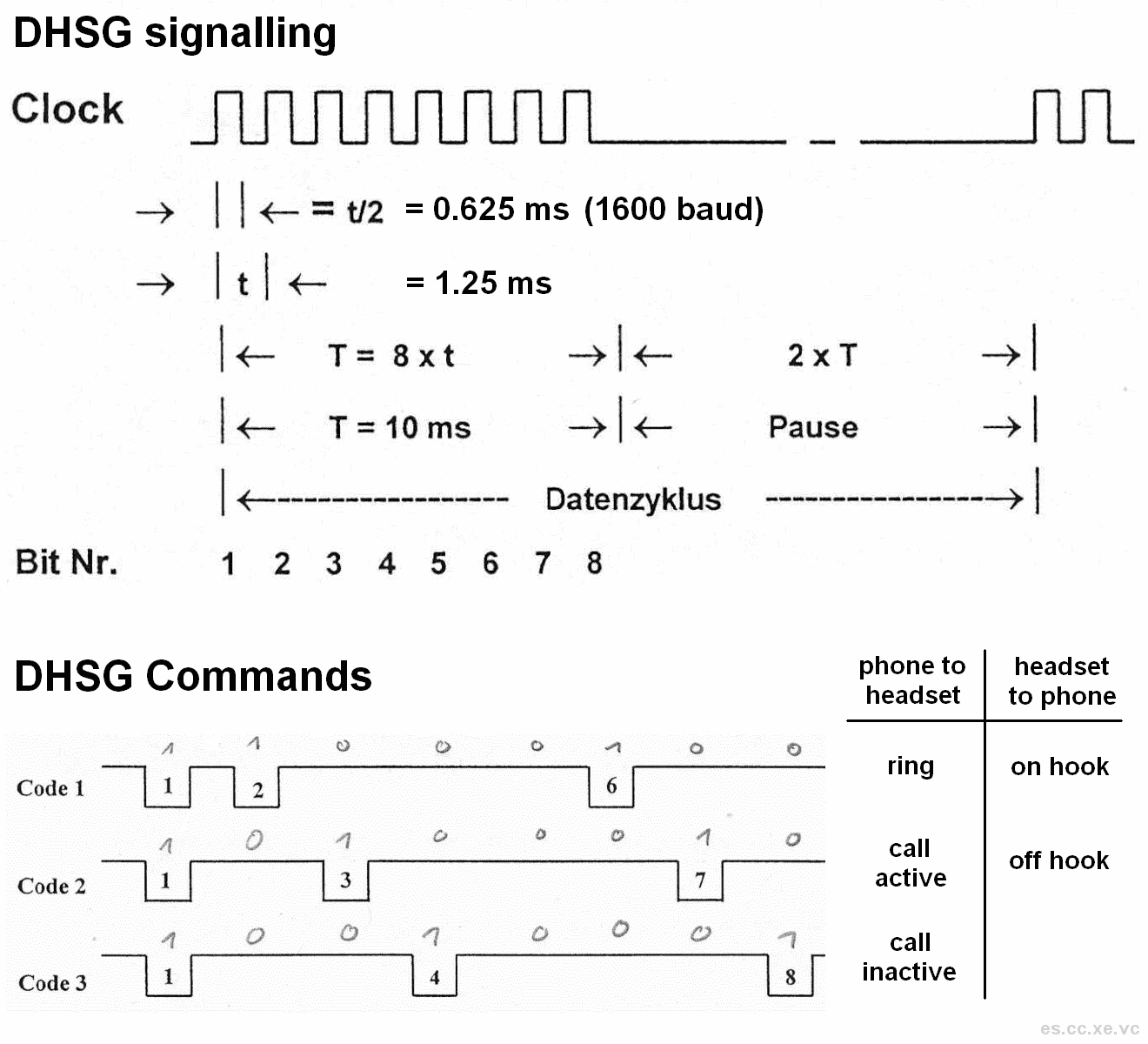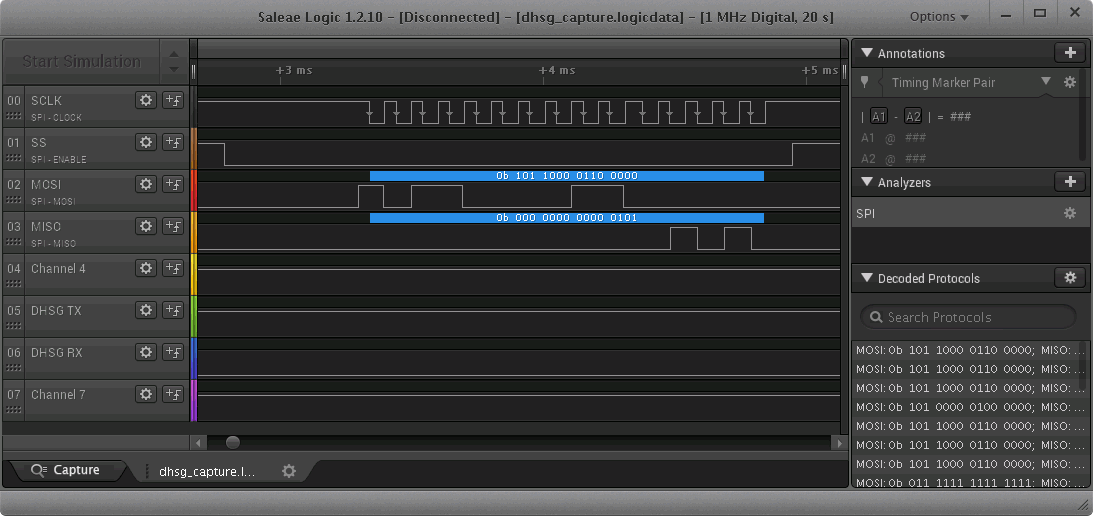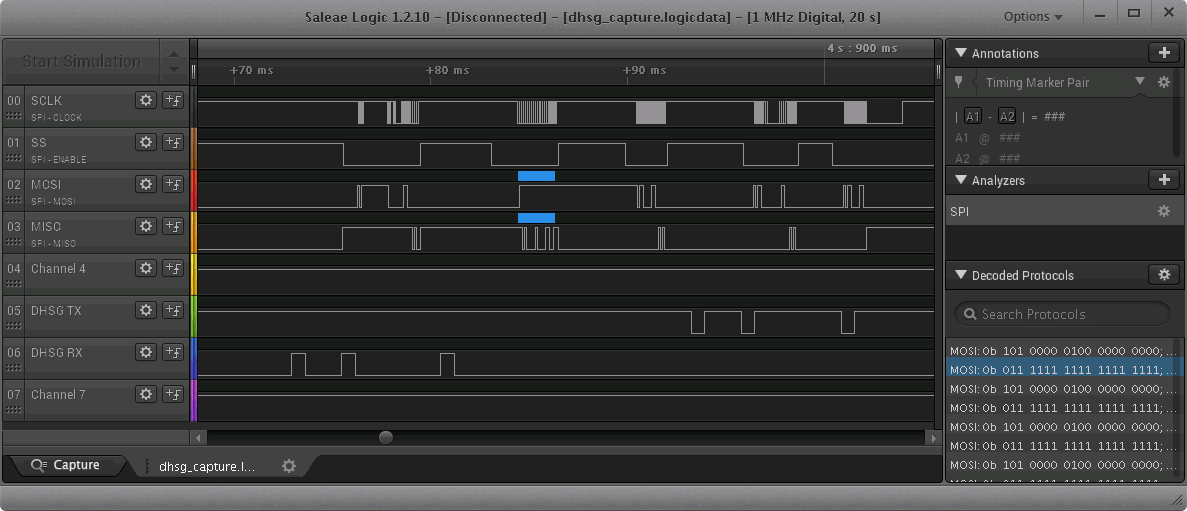If you’ve ever come across wireless headsets for office phones, you might have noticed that “wireless” in this case actually results in a lot more wires on your desk than using a regular wired headset: At least the charging / base station will need an additional power supply, and maybe also an adapter cable to fit the particular phone’s headset jack, since those base stations are rarely sold in multiple variants, tailored to a specific phone model, unlike the most simple wired headsets.
Now there’s one more advantage to wireless than just reducing the chance of accidentally pulling on the cable with an arm (or office chair): You can even leave the desk during calls. Thus it would be great to pickup and hangup calls remotely with a button on the headset – but how should the base station then signal this to the phone?
In mobile phones, this kind of button was considered for wired headsets right from the beginning: The de-facto standard means simply shorting the MIC+ line to GND (directly or with a certain resistor value to distinguish between additional functions like track skipping or volume control).
However, this was never a requirement for desk phones, so the information about ringing, accepting a call or hanging up usually needs to be transmitted out-of-band: Back in the days of analog phones, the most common approach involved mechanical handset lifters that would actually physically move the handset upwards from the phone, so the hook switch would be released or closed when the user presses the button on the headset, thus accepting the call or hanging up.
While this “standard” used to be widely compatible (it just needed to fit the gap underneath the handset), it seemed reasonable for manufacturers of modern ISDN and IP phones to come up with some less hardware-intensive solution – the “Electronic Hook Switch” (EHS).
Obviously, there could not be a common global standard for EHS functionality, but you will probably deal with one of the following (mostly country- or vendor-specific) flavours:
- DHSG (“Drahtlose Hör-/Sprech-Garnitur”, formal German term for “wireless headset”) – probably the most widely deployed standard worldwide by now
- AEI (“Additional Equipment Interface”) – by Avaya
- HHC (“Headset Hookswitch Control”) – for Cisco IP phones
- MSH (“Microphone Short Hook”, as mentioned above for mobile phones, will short the MIC line to GND to signal pickup / hangup) – available in some Alcatel phones
- RHL (“Remote Handset Lifter”, apparently standardized interface for mechanical lifters as mentioned above)
I recently had the chance to play with some Sennheiser DW Pro DECT Headsets at the office – they offer DHSG, MSH and a (proprietary?) Handset Lifter. Our phones are Yealink T46G that do not come with EHS functionality out of the box, but you are supposed to purchase the $40 “EHS36” adapter box by Yealink, which is meant to be compatible with several wireless headset manufacturers (it even comes with a bunch of cables), including Sennheiser (in DHSG mode).
While there seems to be nothing wrong with purchasing one of those adapters for each desk, users report they would crash every once in a while and need to be re-plugged. Also it just made me curious that there is absolutely no information about pinouts or even protocols out there yet, not even a picture of the PCB… So here it is:

The 6P6C (RJ-12) connector on the right goes into the EXT port of the phone through a 1:1 modular cable.
For Sennheiser, a Y-Cable is included that connects the 8P8C port on the base with the 8P8C (RJ-45) port on the EHS36 (left) and the 4P4C (RJ-9) analog headset connector on the phone. Basically, Pins 3-6 for analog audio go into the Yealink phone in reverse order, while Pins 1, 2, 7 and 8 (DHSG Control Pins) go into Pins 3-6 (in this order) of the EHS36 8P8C connector.
For the detailed DHSG pinout, please see the innovaphone wiki:
http://wiki.innovaphone.com/index.php?title=Howto:DHSG_pin_assignment
The specifications are also available for download from there:
http://wiki.innovaphone.com/index.php?title=Howto:DHSG_headset_specification
There’s also some info (in German) about DHSG Y-Cables here, the one for Sennheiser should be similar to this one: http://fschreiner.de/?p=168
I soldered some 0.1″ pin headers to the modular jack pins on the back of the PCB to capture the signalling between phone and headset base while making some test calls.
The DHSG part looks quite straightforward and can also be found in the specifications above:

8P8C pinout at EHS36 (only 3-6 seem to be connected):
Pin 3: GND
Pin 4: DHSG RX (“Bus Send”: headset -> EHS36)
Pin 5: +3.3V
Pin 6: DHSG TX (“Bus Receive”: EHS36 -> headset)
Due to the pause after each bit, it will not work with standard 8 bit hardware UART though.
However I will focus on the interface between phone and EHS36 here:
Here we have SPI with CPOL = 1, CPHA = 0 (“Mode 2”) and a variable bit count, so you probably cannot use most of the hardware implementations available in microcontrollers for this part either, since most of them can only handle fixed 8 bit data chunks.
There’s also an LDO voltage regulator on board that generates 3.3V for the logic levels from the phone’s 5V supply.
6P6C Pinout at EHS36 (conntected to phone’s EXT port):
Pin 1: MISO
Pin 2: MOSI
Pin 3: SS
Pin 4: GND
Pin 5: Vin (+5V)
Pin 6: SCLK
Let’s start with the most frequent signal:
Exactly once per second, the phone will send a 15bit poll message to the EHS box:
15 bit poll: MOSI: 101100001100000 MISO: 000000000000101
(it seems that somewhere between bit 9 and 11 the EHS36 eventually decides to reply with …101)

The same “poll” also occurs in between the 1Hz interval, directly before any other command will be sent.
So let’s ask the EHS36 to signal an incoming call to the headset: On SPI we will have the above “poll” followed by another message (/SS released shortly in between!) that is 21bits in length:
21 bits ring: MOSI: 101000001000000000010 MISO: 000000000000000000000
The EHS36 then signals DHSG Code 1 to the headset base, and you can hear the ringing indicator in the earpiece.
Now what if you press pickup on the headset?
Upon receiving DHSG Code 2, EHS36 will set MISO high, which makes the phone immediately pull /SS low and start generating the clock for a transfer:
At first we see the same “poll” command as above, however MISO is still high during the first 12 bits:
MOSI: 101100001100000 MISO: 111111111111101 (apparently, only the last 3 bits are considered as acknowledge from EHS36 to the polling?)
After that, /SS will be released shortly and a new 19bits transfer is started – the phone will read the command from EHS:
19 bits pickup: MOSI: 0111111111111111111 MISO: 1110100000100011001
EHS36 now confirms with DHSG Code 2 and the call is being accepted by the phone; curiously this is followed by two more “poll” commands with sometimes very delayed SPI clock (phone seems to be busy handling the call). After several hundred milliseconds to establish the call, the phone notifies the headset about the successfull connection again with DHSG Code 2 (this will also happen when you press accept on the phone rather than headset, or after you have dialled a number and the remote party accepts):
Again, we see a “poll” command followed by a signal that is 21 bits in length:
21 bits call established: MOSI: 101000001000000000000 MISO: 000000000000000000000

What’s missing? Hanging up by pressing the headset button!
If the headset base sends DHSG Code 1 during a call, exactly the same will happen on SPI side as for pickup:
A “poll” with first 12 bits MISO high, followed by 19 bits pickup command. This is followed by two “regular poll” commands.
The base then receives DHSG Code 3 as an indicator that the call has been terminated.
Where to go from here?
Using the information above, it should be theoretically possible to build your own EHS-adapter for Yealink <-> DHSG, though this would most probably not be cheaper than buying the original one in the small scale.
However, you could add some nice features like Busy Light Indication – think of a little LED sign on your desk that shows clearly whether you are available or not?
There seems to be no busy light on the market yet that natively uses the EXT port on Yealink phones – all that money can buy at the moment will use workarounds like monitoring the state of the microphone audio line between phone and headset – through another little black plastic box on your desk… *sigh*
For the kuando Busylight Combi, for example, there’s even a dual version that allows you to use *either* handset or external headset, by looping both microphone lines through the box…
http://www.plenom.com/support/kuando-busylight-combi/installation/
So stay tuned for my future attempts of putting EHS, Sennheiser Y-Cable and Busy Light Ddetection all into one little box 🙂
Would it be possible to send the 8Bit Data with a Arduino?
I would like to connect a raspberry with a DHSG compatible phone to receive Phone Calls.
Sure, you could use anything like Arduino, Raspberry, ESP8266, … to connect to the DHSG bus lines. The specifications allow for 2.9 – 5V on the logic lines, so any of them should be fine without additional level shifters.
You will just have to do all the timing and GPIO manipulation / signal detection manually, i.e. set up a timer for 1600 Hz and alternately transmit one data bit and a zero bit when the interrupt fires to send a DHSG message.
For receiving, you would look for a rising edge on the DHSG line, wait 0.3125ms and then read the PIN state every 1.25ms (or 0.625ms to include the zeroes if you want to be more precise), write it into a buffer and check whether the result matches a valid DHSG code 🙂
Hi Sebastian,
thank you for the tip. With this information i got the read Part running but the send Command is not working 🙁
///////////////////////////////////
int buttonStateRising = 1;
int lastButtonStateRising = 1;
int i;
String Code;
int phonePin = 8;
void loop(){
readPhone();
if (Code == “1101111”){
Serial.println(BTModu.stdCALL());
parseSerial();
}
else if (Code == “1111011”){
Serial.println(BTModu.stdEND());
parseSerial();
}
Code = “”;
}
void readPhone(){
buttonStateRising = digitalRead(phonePin);
if ((buttonStateRising == HIGH) && (lastButtonStateRising == LOW)) {
Serial.println(“There was a rising edge on pin 8”);
delayMicroseconds(625/2);
for (i=0; i<7 ; i++){
if (digitalRead(phonePin) == HIGH){
//Serial.println(1);
Code += 1;
} else {
//Serial.println(0);
Code += 0;
}
delayMicroseconds(625);
}
delay(20);
Serial.println(Code);
}
lastButtonStateRising = buttonStateRising;
}
////////////////////////
Keep in mind there is actually a low phase in between two data bits, so when sampling with a delay of 625µs you should be reading 16 data bits including the pauses, i.e. Code 1 would be HLHLLLLLLLHLLLLL on the bus (thus I wondered whether your code is actually working 🙂 ).
For reading (assuming there will only be valid DHSG signals) you might as well delay 1250µs and just read the 8 data bits: HHLLLHLL.
However for sending, you always have to include the pause bits to meet the specifications.
I think you could do something like…
int code1 = 0b10000000101;
while(code1){
digitalWrite(dhsgOut, code1 & 1);
code1 >>= 1;
delayMicroseconds(625);
}